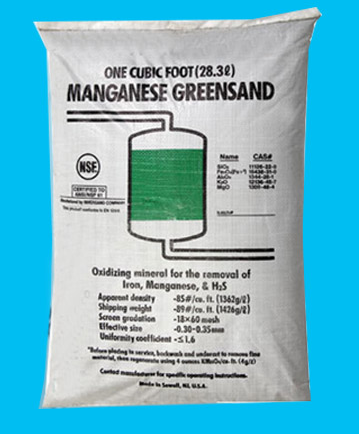Manganese Greensand USA
Manganese Greensand is formulated from a glauconite greensand and is capable of reducing iron, manganese and hydrogen sulfide from water through oxidation and filtration. Soluble iron and manganese are oxidized and precipitated by contact with higher oxides of manganese on the greensand granules. The hydrogen sulfide is reduced by oxidation to an insoluble sulfur precipitate. Precipitates are then filtered and removed by backwashing. When the oxidizing capacity power of the Manganese Greensand bed is exhausted, the bed has to be regenerated with a weak potassium permanganate (KMnO4) solution thus restoring the oxdizing capacity of the bed. 1½ to 2 ounces of potassium permanganate, in solution, per cubic foot of Manganese Greensand is considered sufficient for normal regneration. It is required to vigorously backwash and regenerate the bed when it is placed in service and before its oxidation capacity is totally exhausted. Operating the bed after oxidation capacity is exhausted will reduce its service life and may cause staining.
 ADVANTAGES
ADVANTAGES
• Iron reduction over wide pH range
• Effective reduction of hydrogen sulfide in addition to iron and/or manganese
• No harmful effects from a chlorine feed
• Low attrition for long bed life
PHYSICAL PROPERTIES
• Color: Black
• Bulk Density: 85 lbs./cu. ft.
• Specific Gravity: 2.4-2.9
• Effective Size: 0.30-0.35 mm
• Uniformity Coefficient: 1.6
• Mesh Size: 18-60
• Attrition Loss Per Year: 2%
CONDITIONS FOR OPERATION
• Water pH range: 6.2-8.5
• Maximum water temperature: 80°F/26.7°C
• Bed depth: 30 in.
• Freeboard: 50% of bed depth (min.)
• Regeneration: 1.5-2 oz of KMnO4 by weight per cu. ft.
• Service flow rate: 3-5 gpm/sq. ft., 8-10 gpm/sq. ft. intermittent flow possible
• Backwash flow rate: 10-12 gpm/sq. ft.
• Backwash bed expansion: 40% of bed depth (min.)
• Maximum practical limit of iron (Fe++) or manganese (Mn++) in raw water: 15 ppm
• Maximum practical limit of hydrogen sulfide (H2S): 5 ppm


